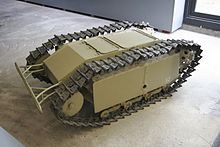Goliath tracked mine
This article includes a list of references, related reading, or external links, but its sources remain unclear because it lacks inline citations. (August 2010) |

The Goliath tracked mine - complete German name: Leichter Ladungsträger Goliath (Sd.Kfz. 302/303a/303b) - was a remote controlled German-engineered demolition vehicle, also known as the beetle tank[citation needed] to the Allies.
Employed by the Wehrmacht during World War II, this caterpillar-tracked vehicle was approximately 4 feet (1.2 m) long, 2 feet (0.61 m) wide, and 1 foot (0.30 m) tall. It carried 75–100 kilograms (165–220 lb) of high explosives and was intended to be used for multiple purposes, such as destroying tanks, disrupting dense infantry formations, and demolition of buildings and bridges.
Development and use



In late 1940, after recovering the prototype of a miniature tracked vehicle developed by the French vehicle designer Adolphe Kégresse from the Seine River, the Wehrmacht's ordnance office directed the Carl F.W. Borgward automotive company of Bremen, Germany to develop a similar vehicle for the purpose of carrying a minimum of 50 kg of explosives. The result was the SdKfz. 302 (Sonderkraftfahrzeug, ‘special-purpose vehicle’), called the Leichter Ladungsträger (‘light charge carrier’), or Goliath, which carried 60 kg of explosives. The vehicle was steered remotely via a joystick control box. The control box was attached to the Goliath by a triple-strand cable connected to the rear of the vehicle, for transmitting power to the electric driven version. Two of the strands were used to move and steer the Goliath, the third was used for detonation. The Goliath had 650 m of cable. Each Goliath was disposable, being intended to be blown up with its target. Early model Goliaths used an electric motor but, as these were costly to make (3000 Reichsmarks) and difficult to repair in a combat environment, later models (known as the SdKfz. 303) used a simpler, more reliable gasoline engine.
Goliaths were used on all fronts where the Wehrmacht fought, beginning in spring 1942. They were used principally by specialized Panzer and combat engineer units. Goliaths were used at Anzio in Italy in April 1944. Goliaths were used most notoriously in the Warsaw Uprising of 1944, as Wehrmacht and SS units were deployed to crush fierce Polish resistance by the Polish Home Army (Armia Krajowa). As the Poles had only a small number of antitank weapons, volunteers were often sent to cut off the command cables of the Goliath before it reached its intended target.[citation needed] A few Goliaths were also seen on the beaches of Normandy during D-Day, though most were rendered inoperative due to artillery blasts severing their command cables.
Although a total of 7,564 Goliaths were produced, the single-use weapon was not considered a success due to the high unit cost, low speed (only just above 6 mph, or 9.5 km/h), poor ground clearance (just 11.4 centimeters), vulnerable command cables and thin armour which failed to protect the remote bomb from any form of antitank weapons. However, the Goliath did help lay the foundation for post-World War II advances in remote-controlled vehicle technologies.
Surviving examples
Surviving Goliaths are preserved at:
- the Deutsches Panzermuseum, Germany
- Heeresgeschichtliches Museum, Vienna, Austria
- the Musée du Débarquement Utah Beach, Normandy, France
- Musee No. 4 Commando, Ouistreham, Normandy, France
- the Canadian War Museum, Ottawa, Ontario, Canada
- Fort Garry Horse Museum, Winnipeg, Manitoba, Canada
- United States Army Ordnance Museum
- Karl Smith collection, USA
- the Imperial War Museum Duxford, UK
- the Bovington Tank Museum, UK
- The REME Museum, UK
- Dutch Cavalry Museum, Netherlands
- War Museum Overloon, Netherlands
- Royal Museum of the Armed Forces and Military History, Belgium
- the Kubinka Tank Museum, Russia
- Arsenał in Wrocław, Poland
- Polish Army Museum, Poland
- Warsaw Uprising Museum, Poland
- Muzeum dopravy (transportation museum), Bratislava, Slovakia.
See also
Notes
Defense against the German Goliath was reenacted in the 1957 Polish film Kanal, documenting the final days of the Warsaw uprising.
References
- Chamberlain, Peter, and Hilary Doyle (1999). Encyclopedia of German Tanks of World War Two, 2nd ed. London: Arms & Armour. ISBN 1-85409-214-6.
- Jaugitz, Markus (2001). Funklenkpanzer: A History of German Army Remote-and Radio-Controlled Armor Units, trans. David Johnston. Winnipeg, Manitoba: J.J. Fedorowicz Publishing, Inc. ISBN 0-921991-58-4.
- Jentz, Thomas L. Panzer Tracts, No. 14: Gepanzerte Pionier-Fahrzeuge (Armored Combat Engineer Vehicles, Goliath to Raeumer). S. Darlington, Maryland: Darlington Productions. ISBN 1-892848-00-7
- Morison, Samuel Eliot (1957). History of United States Naval Operations in World War II vol. 11. Boston, Mass.: Atlantic Monthly Press.
External links
- Dutch Cavalry Museum has a Goliath-tank in its collection.
- Relicnews.com has some additional pictures and info that may be of interest. Copyright of the pictures cannot be confirmed so they are linked rather than lifted.
